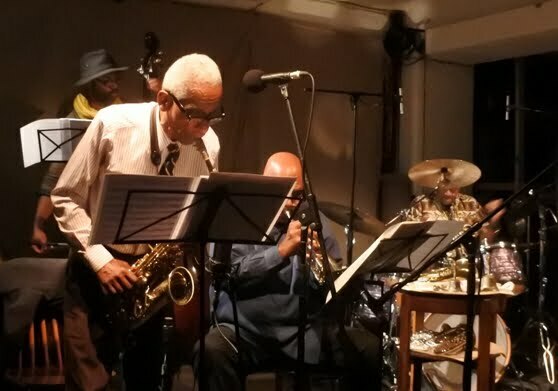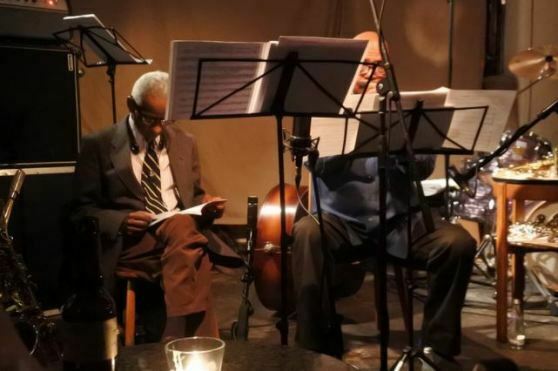
Some shows you just don’t expect to see. The Art Ensemble of Chicago is a group so bound up in legend and an aura of uniqueness, that having them turn up in Hackney in 2017 feels almost absurd. I’ve listened to them, and read about them, for years, but had no inkling of their still existing. They were something that happened back then, in the middle of the times that I had missed.
But the world’s premiere avant garde jazz group, with the coolest name for any group ever, famed for their musical invention, attitude, and creative stage presence, is still with us. Not all of them alas – trumpeter Lester Bowie died in 1999 and bassist Malachi Favors in 2004. But founder member Roscoe Mitchell (woodwinds) and early recruit Don Moye (drums and percussion) are still there, both now in their seventies, with multi-trumpeter Hugh Ragin and the almost disrespectfully young bassist Junius Paul making up the numbers. And so the band plays on.
The Art Ensemble of Chicago were famed for how they incorporated elements of performance art into their shows, with costumes and face paint all part of the kaleidoscopic, polythematic approach which had them incorporating all kinds of musical styles of instruments to create a music beyond music. Some of this comes across in their recordings, if erratically so – you always sensed that the full reality only existed in performance. So reading about them felt as exhilarating as listening to them, if not more so. Because I would never get a chance to see them.
The Art Ensemble of Chicago, live in Hamburg, 1991
And then they turn up at the Café Oto in Hackney, London’s home for avant garde music, for a three-might residency. The grizzled faithful turned up, many of whom (one learned from conversations in the queue) had seen the group in times past, in their theatrical prime. So what would we get now?
The Café Oto is plain, as venues go. A horseshoe of chairs surrounds a narrow performance space, with a bar at the back. If you arrive when the doors open you will find a queue in place and all the seats quickly taken for such a starry offering, with standing room only for the latecomers.
We then waited an hour, but in a way the performance had already begun. Roscoe Mitchell, dressed immaculately in jacket and tie, sat nonchalantly to one side eating his supper. He moved to the performance space, cleaned the keys of assorted saxophones, then sat and read a book. Around him was an array of instruments, with a round table filled with trumpets or various sizes and assorted bells (always a vital part of an Art Ensemble of Chicago performance). We politely watched all this, waiting.

The others came on stage, Moye shuffling on with walking stick, to be freed from physical infirmity the moment he sat at the drum stool. Then they began. It was utterly extraordinary. First they all stood and turned to the left, looking at whatever (East, maybe?). They then played just the one piece. It started out more or less just the one note shared by saxophone, trumpet and bass, sustained on and on, followed by strange interweavings of saxophone and trumpet that went in and out of atonality, gradually building up in tempo. There followed solos of increasing dexterity by each, with Ragin uncovering high pitched notes from a trumpet such as most cannot have expected to exist, or be possible, Paul displaying such disciplined dexterity, while Moye’s years fells away in a masterly display of polyrhythmic invention. This was all topped by a solo from Mitchell of such extraordinary attack that the audience was left stunned. The 77-year-old had a young man’s fingers and the lungs of a elephant.
Then the tempo picked up again until all played together at a ferocious pace with a blizzard of notes that defied the logic of breathing. Mitchell kept mostly to the one saxophone, Ragin worked his way through a collector’s cornucopia of different trumpets. A wall of intense music noise was sustained for fifteen minutes or more – certainly beyond the point where you might have expected human musical endurance to have taken you. On and on and on it went, befuddling the brain. Gradually it slowed down, and over a swinging beat Mitchell introduced each member of the band. Then a grand crescendo and it was over.
It was only an hour. Though they left the stage you weren’t quite sure whether there was going to be more or not, but once they started packing up we realised how things were. In one way it was a conventional jazz set up: a quartet had improvised around some agreed themes, each had taken a solo, it all built up to a grand finale, and then ended. But it was more than that. Though the Art Ensemble of Chicago no longer don face paint or dress extraordinarily (Moye sported a tasteful African costume), and though there was no free space to put on a theatrical show even if they had wanted to, they remained true to their goal – creating “Great Black Music – Ancient to Modern”. It was timeless, positioning itself at just that point where everyone else’s music stopped.
My thought after listening to the concert was “you couldn’t sample any of that”. The reproducibility of music today, where everything can be built on what the previous person left behind, has been an opportunity for creativity, but also an admission of defeat. It says we can only look backwards, that our best ideas are over. Music that cannot conceivably be copied, which exists only in performance and which no other set of musicians could imagine recreating, rescues music. The sound that evening may only have been to the taste of a few, but the spirit it expressed had importance for many. It was music set free.